Your cart is currently empty!
Information & Resources
Page index
- Achieving a Successful Seeding Project
- Seed Selection
- Seed Quality
- Seed Testing and labeling
- Certified Seed
- Source identified Seed
- Site and purpose adapted seed
- Custom Seed Collections
- Custom Seed Mixing
- Pure live seed
- Seed is Cheap
- Named Releases
- Species Descriptions
- Adaptation Maps
- Plant Species Names (Plant Taxonomy/Nomenclature)
Achieving a Successful Seeding Project
We would like to say that Stevenson Intermountain Seed, Inc.’s seed is so good all you have to do is throw it out on any old rock and it will grow. However, the fact is that even though our seed is the best you can get it takes a lot more than just throwing it out to get the best results. This website was developed to contain most or all the information you need to design and achieve a successful seeding project.
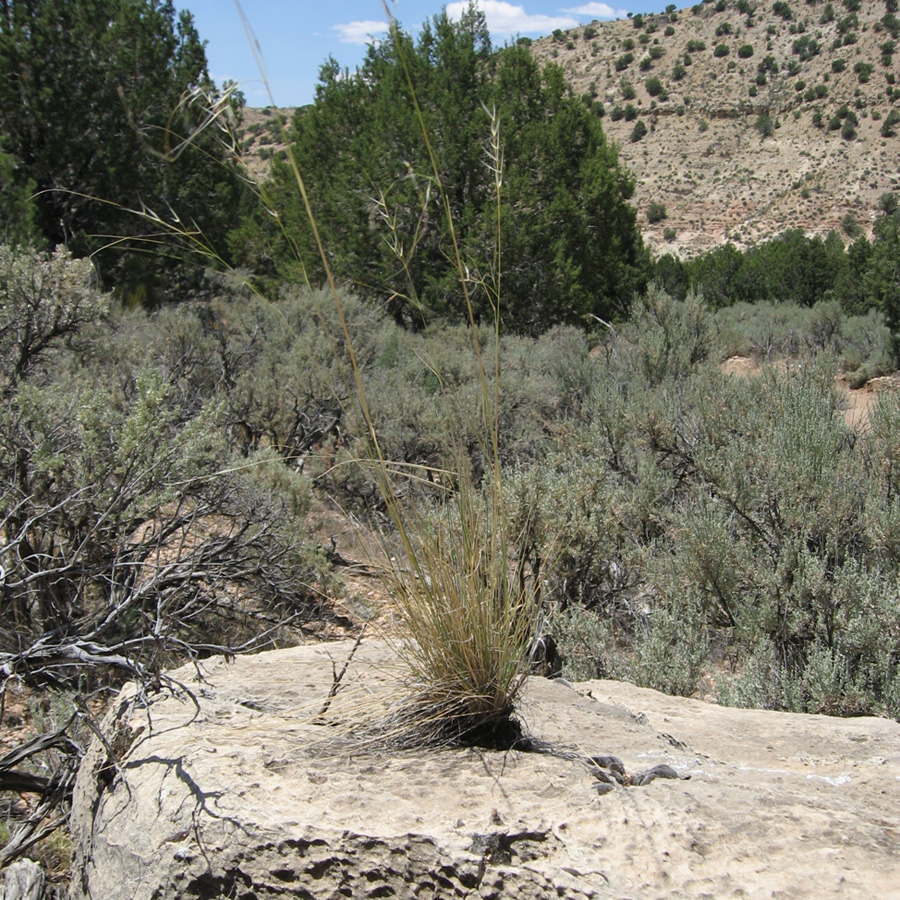
Seed Selection
Our selection of species and varieties comes from multiple sources throughout the western United States so we are able to offer our customers an extensive and complete selection of over 400 species and varieties of shrub, grass, forb, legume and wildflower species. Most of the species we offer are native to the US but when nonnatives are needed or desired to meet the requirements of a specific project we have them available also. Much of the seed we offer is produced in fields under intensive agronomic practices by a number of expert seed producers in the west. We also specialize and excel in seed harvested from native species in western wildlands and offer an excellent selection of species harvested from throughout the west from various elevations, climatic zones, and soil types to ensure a source of ecological compatibility for the specific requirements of most any project.
Seed Quality
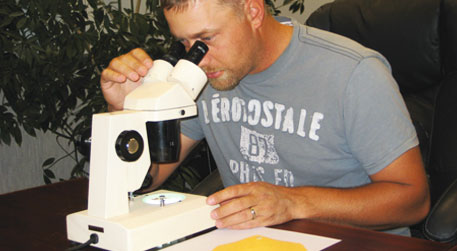
Providing top quality seed products is one of our highest priorities and our long-standing reputation for quality backs up our claim. We employ and utilize only those people who have the same commitment to quality as we do. This includes both our experienced and welltrained native wildland seed collectors and our agronomic seed growers. Also, much of our seed is processed or conditioned at our own modern and well-equipped seed conditioning facilities. Here, our well-trained and experienced seed conditioning technicians take great pride in producing superior quality seed for our customers. These factors combined assure our customers the best seed products available on the market. Jason Stevenson inspecting quality of a seed lot.
Seed Testing and Labeling
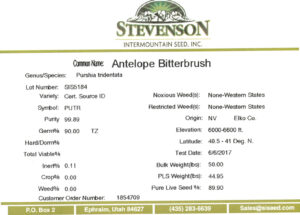 All of our seed is tested for purity, germination, other crop seeds, weed seeds and other characteristics by a registered seed laboratory. Each bag is then labeled with all of the appropriate and required seed information in accordance with State and Federal regulations. This ensures our customers are getting exactly what they need and expect.
All of our seed is tested for purity, germination, other crop seeds, weed seeds and other characteristics by a registered seed laboratory. Each bag is then labeled with all of the appropriate and required seed information in accordance with State and Federal regulations. This ensures our customers are getting exactly what they need and expect.
Certified Seed
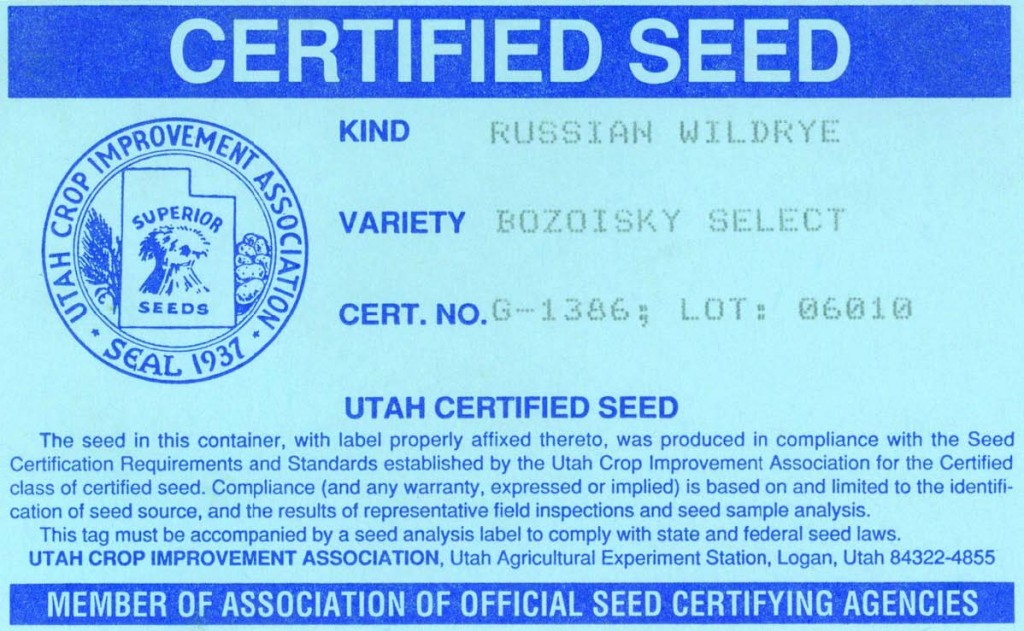
Stevenson Intermountain Seed, Inc. promotes the use of “Certified” seed when possible. Certified seed guarantees a specific, known and tested genetic identity as well as high quality as related to purity, germination, other crop seed and weed seeds. Each state has an authorized seed-certifying agency. Only seed with a named release (Except for the Source Identified Class) such as the named variety/cultivar “Magnar” Great Basin Wild-rye can be “Certified”.
In order to qualify as certified seed the state certifying agency makes sure the regulations for certified seed are followed by inspections during the planting, growing, harvesting and conditioning of each lot of seed.
Source Identified Seed
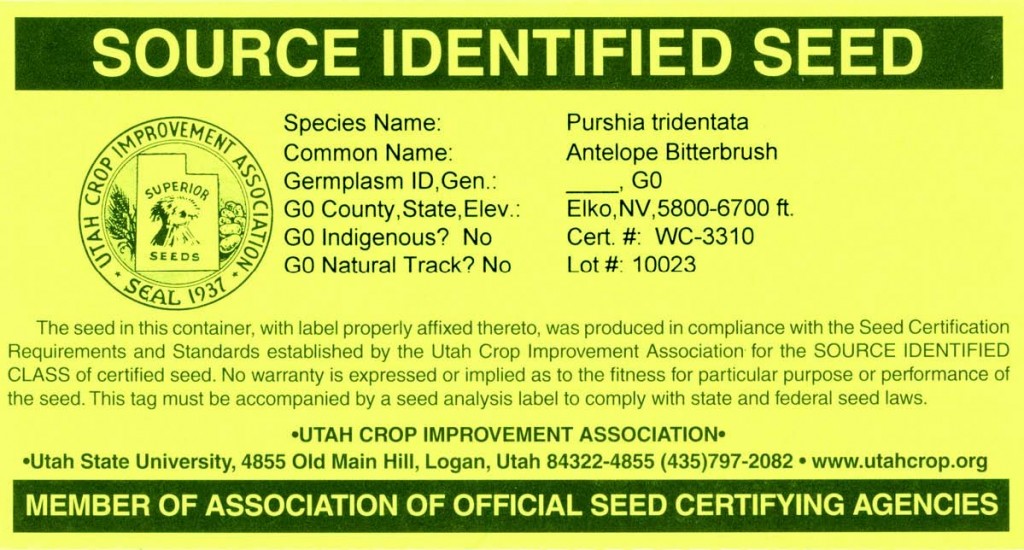
Stevenson Intermountain Seed, Inc. identifies and keeps tract of the origins of every lot of seed it sells. Knowing the origin and associated ecological conditions of the origin of a seed lot is important. This allows us to match lots of seed with similar ecological conditions to the ecological conditions of the planting site to ensure compatibility.
The Association of Official Seed Certifying Agencies (AOSCA) has a class of seed certification for wildlandharvested seed called “Source Identified Class”. The “yellow tags” associated with this certified seed class verifies the origin of a particular lot of seed.
Site and Purpose Adapted Seed
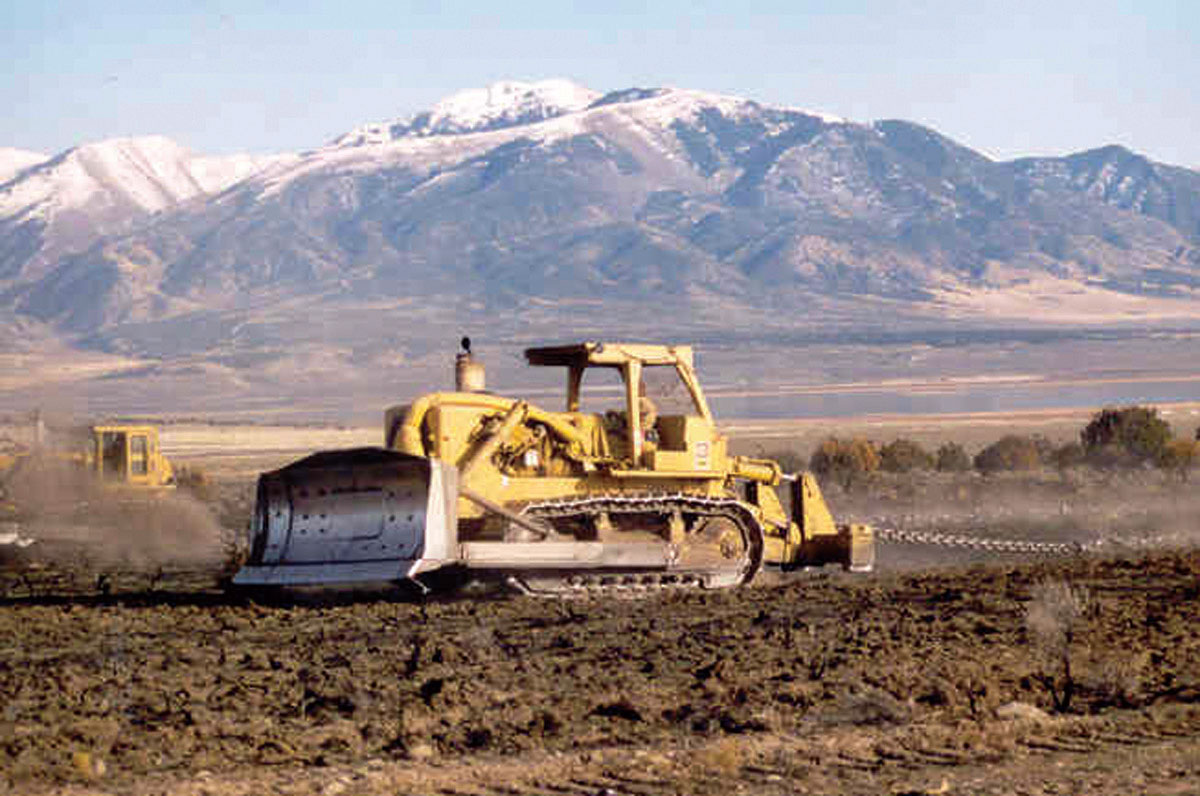
All sites that are being planted have specific environmental and ecological factors such as soil types, elevations, slopes, exposures, climates, latitudes, etc. These factors as well as others like “intended uses” of a project area after restoration and budgets must be identified during the planning of a project.
Environmental and ecological factors of a planting site must be determined because each species or variety of a plant has specific ecological conditions in which it will excel or at least perform satisfactorily. Also, each plant species has specific characteristics that make it superior or at least suitable for its intended purpose.
An example of selecting “Site and Purpose Adapted Seed” is as follows. First the planting site conditions must be determined. Our example site is located in the Great Basin area of Nevada. The elevation is 5,000 ft. and the latitude is 41 degrees north. The soil is somewhat shallow with a gravely, sandy-loam texture and has low-moderate levels of salinity and alkali. It receives 9-10 inches of annual precipitation, most of it in the winter as snow but also some in the spring. Temperatures can range from minus 25 F. to 100 F.. Terrain is valley bottoms and gentle sloped hills surrounded by higher mountains not in the project area.
The goals of the project are:
- To reduce soil erosion
- Restore a diverse, self-sustaining native plant community and ecosystem.
- Provide a good diverse habitat for a number of species of small and large wildlife including birds, reptiles and insects
With these factors known, the suitable species can be determined. Some suitable grass species would be: Bottlebrush Squireltail, Sandberg Bluegrass, Western Wheatgrass, Needle-and-Threadgrass and Indian Ricegrass. Some suitable forb species would be: Western Yarrow, Scarlet Globemallow, Lewis Flax, and Thickleaf or Palmer Penstemon. Some suitable shrub species would be: Fourwing Saltbrush, Shadscale, Winterfat, Black Sagebrush, Nevada Ephedra and Spiny Hopsage.
Budgets also become a factor, as the cost of some species is more than others.
Knowing this information is vital so site-adapted and purpose-adapted seed can be determined and used for your specific projects to achieve the desired goals.
Stevenson Intermountain Seed, Inc. can help you select the site-adapted and purpose-adapted seed needed for your site and land use goals from our complete selection of grass, forb, wildflower and shrub species.
Custom Seed Collections
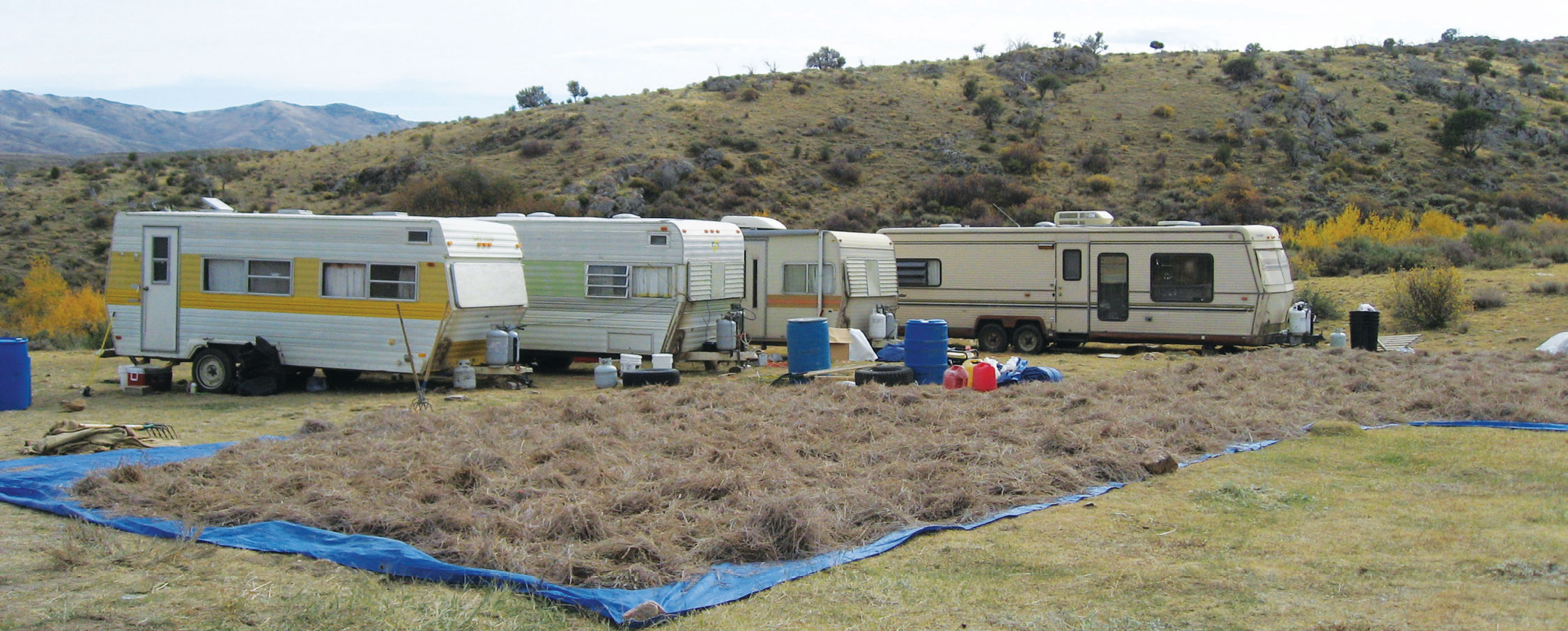
Stevenson Intermountain Seed, Inc. offers a custom seed collecting service where our well-trained seed collectors will come to your site and collect seed. We have 35 years of experience in wildland seed collections giving us the expertise necessary to successfully carrying out this kind of project. A number of factors go into a site-specific seed collection such as the lead-time required before the seed is needed, amount of seed needed and what species, budgets, seed collection potential for the site and more. If you are interested please contact us for an evaluation.
Custom Seed Mixing
Stevenson Intermountain Seed, Inc. will custom mix any species of seed you specify; usually at no charge. So whether your project is for wildlife habitat, pasture, wildfire revegetation, mining or watershed restoration, beautification or other purposes we can mix the best species for your project correctly for planting and a successful project.
Technical Help For Species Selection
We have expert help available if you need it for selecting the species that will best achieve your project goals.
Pure Live Seed (PLS)
Understanding the meaning and importance of the term “ Pure Live Seed” is important in both ordering and planting seed. “Pure Live Seed” (PLS) is a determination of the percent of seed of a seed lot that is pure and viable, or will germinate. To calculate the percent of PLS a seed lot has the percent purity of the seed lot is multiplied by the percent germination and then divided by 100. For example a seed lot with 90% purity and 90% germination has a PLS percent of 81%. Material in a seed lot that is not pure seed can include things like seed chaff, other crop seed, dirt, and weed seeds. The percent purity of a specific seed lot depends on the amount of these things.
Most lots of seed have seed that will not germinate so the percent germination is less than 100%. The seed that is not viable and will not germinate is because of factors such as damage from disease, insects, frost and other things.
Determining the Pure Live Seed percent of a seed lot is the way you can calculate the true value of a seed lot in regards to purity and germination and compare one seed lot with another.
For example a lot with a 90% purity and a 90% germination and a PLS rating of 81% is worth more than a lot of seed with an 80% purity and a 80% germination and a 64% PLS rating. In fact the first lot is worth 21% more than the second lot.
Other things may also need to be considered in determining the value of a seed lot such as origin, weeds, other crops, etc. as they may be as important as the price.
Knowing the PLS percent of a seed lot is very valuable in determining the correct planting rate for a project also. The lower the PLS percent a lot of seed has, the more bulk lbs. of seed will need to be planted to achieve the correct planting rate.
Pure Live Seed Percent (%PLS) = (Purity x Germination) divided by 100.
A Word About Seed Prices

As you know most land restoration seed or land improvement seed is sold on a per pound basis. This is ok and a fair way to establish the cost of seed of a particular species. However, this criteria does not accurately or at least completely describe the actual value you are receiving for your dollars spent on seed. The reason being is that what you are actually buying is individual seeds not pounds and the number of seeds in a pound of seed is usually many, thousands even millions.
For example if a PLS (pure live seed) pound of Wyoming Big Sagebrush is sold for 50.00/ PLS one may well think that 50.00 is a lot of money for one pound of seed. But on further evaluation we find one PLS lb. of Wyoming Big Sagebrush has approximately 1,500,000 viable seeds in it. Therefore on a per seed basis each seed costs .0033 cents per seed or you can buy 303 seeds for a penny. This is amazing to me that 303 seeds that are hand harvested from the wild and all 303 are new potential sagebrush plants can be bought for one penny. That is a bargain to me and sounds very cheap.
Other examples are as follows:
| Species | Cost/PLS lb. | Approx. PLS Seeds/lb. | Number of seed that can be purchased for a penny |
|---|---|---|---|
| Sand Dropseed | 4.75 | 7,750,000 | 10,000 |
| Indian Ricegrass | 6.00 | 145,000 | 241 |
| Western Yarrow | 25.00 | 2,500,000 | 1,000 |
| Palmer Penstemon | 18.00 | 540,000 | 300 |
| Antelope Bitterbrush | 16.00 | 13,500 | 8.5 |
| Fourwing Saltbrush | 14.00 | 27,500 | 20 |
As you can see the number of seeds you can buy for a penny does vary quite a bit depending on the size of the seed and its cost per pound. However, when you look at the cost of this type of seed on a per seed basis it sure looks like a bargain to me whether you are only buying 5 seeds for a penny or 10,000 seeds for a penny each are a potential plant with a significant value in a land restoration or improvement project.
I hope you will think of this next time you think seed is expensive.
Named Releases
For many years people and organizations have worked diligently to find and or develop plant materials that would be suitable or excel in land restoration, land improvement, conservations or similar efforts. When successes were achieved according to established standards or requirements the results were usually documented and the product given an identifiable name by which it could be known by and marketed by to those wishing to use it. The end product is usually known as a “named release.” The terms “variety” and “cultivar” are usually used synonymously but this may not be totally correct.
Seed certification assures verification for the ‘named release’ or germplasm identity as listed on a seed analysis label on a bag of seed. The assurance is provided by official seed certifying agencies and in accordance with their set standards for seed certification.
In general, four classes of certified seed for named and released crop varieties are recognized by seed certification agencies: Breeder, Foundation, Registered and Certified. A distinctive tag is attached to each bag to denote the seed class.
- Breeder seed (white tag) is very limited in amount and is directly produced or controlled by the originating plant breeder or institution. This seed is normally not available in commercial channels. Breeder seed provides the source for the increase of Foundation seed.
- Foundation seed (white tag) is the progeny of either Breeder or Foundation Seed Program of either the public or private institution controlling the variety.
- Registered seed (purple tag) is the progeny of either Breeder or Foundation seed. Registered seed is available in regular market channels and is normally required to produce certified seed. Many perennial crop varieties do not have a registered class specified.
- Certified seed (blue tag) is the most commonly encountered certified seed and is the large-volume class sold for use on land restoration and similar projects. It is the progeny of either Foundation or Registered seed stock. Under certain circumstances the progeny of Certified seed can be recertifies as long as the genetic identity, varietal purity and other standards are maintained.
Nomenclature for “Pre-Variety Germplasm” (germ-plasm that has not been released as a variety; may be either wild collected or field grown seed) is as follows: Source Identified, Selected, and Tested. Generations of these germ-plasms grown in the field are indicated by G1, G2, and G3, etc. and are noted on the distinctive tag color for each type along with germ-plasm and/or collection area designation.
- Source Identified Germplasm (yellow tag)is seed or other propagating material collected from natural stands or produced in seed fields where no selection or testing of the parent population has been made. When seed is collected from a natural stand, the generation is GO.
- Selected Germplasm (green tag) is the progeny of phenotypically selected plants that have promise, but not proof, of heritability of distinctive traits, and may be collected from natural stands or produced in seed fields.
- Tested Germplasm (blue tag) is the progeny of either Breeder or Foundation seed. Registered seed is available in regular market channels and is normally required to produce certified seed. Many perennial crop varieties do not have a registered class specified.
- Certified seed (blue tag) is the progeny of plants, which have been tested for stable heritability of distinctive genetic traits, and may be collected from natural stands or produced in seed fields.
Species Descriptions
The species descriptions on this site are brief but still provide a significant amount of useful information required for species selection for specific projects. However, more detailed information may be required to select the most appropriate species for a specific project.
The descriptions were compiled by review of the available published information, personal communication with experts in the field and from personal observations. Some variations and discrepancies exist among the various information sources.
Adaptation Maps
The following maps displayed by each species represents the broad geographic range in which that species is expected to be able to establish and persist if the environmental and ecological factors such as climate, soils, elevations etc. needed for that species exist. Sometimes the area of adaptation is an area more broad than the native range of the species.
Plant Species Names (Plant Taxonomy/Nomenclature)
The following plant species descriptions use the most widely accepted botanical nomenclature (scientific names) and common names to identify them. However, common names can vary from place to place and person to-person so standardized botanical nomenclature names most accurately identify a species. However again, because of recent advances in botany a number of plant botanical names have been changed and continue to change. We have tried to keep up-to-date on this issue in this website and indicate the old names that some may still be more familiar with.